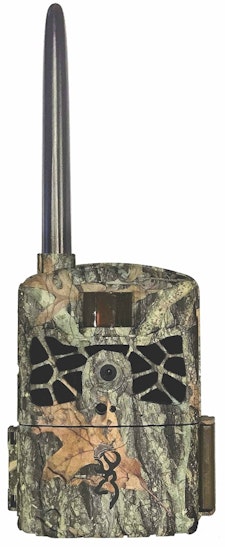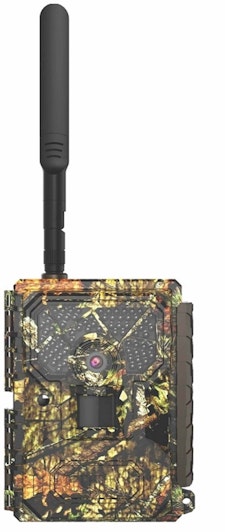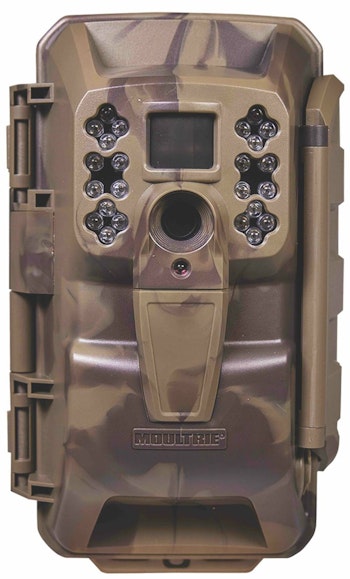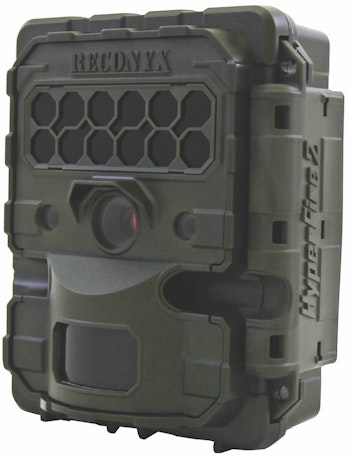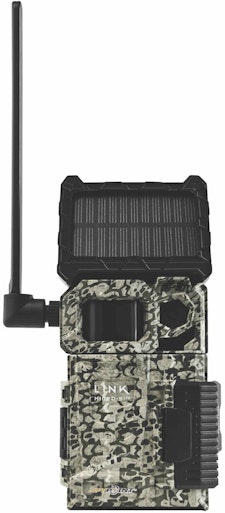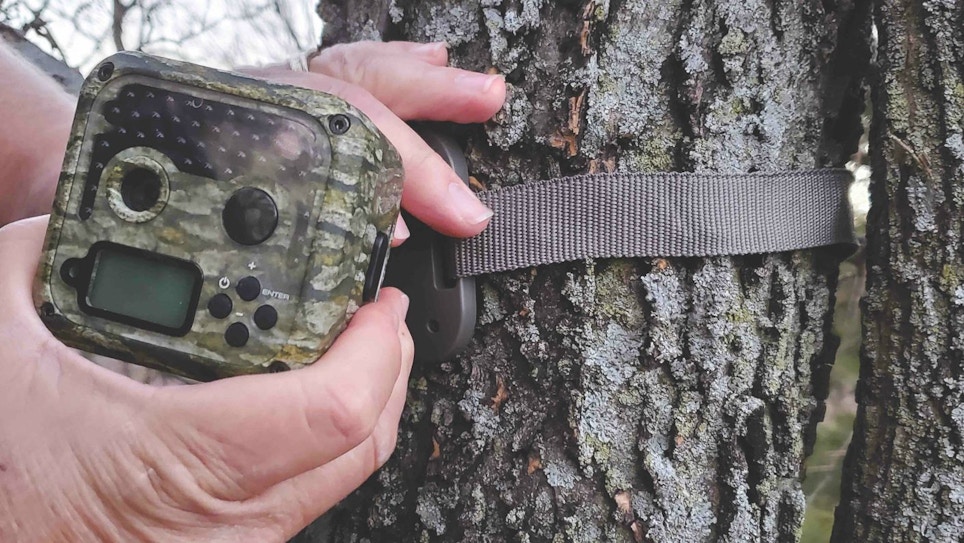
As cameras get smaller and more affordable and offer more features than ever, customers are running multiple cameras on a single piece of property, and most are willing to upgrade every few years.
Outdoor photographer and U.S. Representative George Shiras III published the first trail camera photo with National Geographic in 1906, taken with a contraption he called a “trap camera.” The 74-photo montage caught the attention of then President Theodore Roosevelt, who suggested Shiras publish a book of his works. Shiras complied nearly 30 years later by publishing Hunting Wild Life with Camera and Flashlight: A Record of 65 Years’ Visits to the Woods and Waters of North America, which included more than 950 trap camera photos in two volumes.
Shiras understood the important role cameras could play in understanding wildlife activity when no one was looking. What he may not have realized was the magnitude of change he created in the way we scout, plan and hunt in 2019, more than 70 years after his death. While his early trap camera was primitive, blinding and loud and only took one photo, by the 1950s, trap cameras had evolved into 35mm cameras capable of capturing up to 36 images in a single setting. Of course, by the late ’80s, motion sensors were becoming the standard, and soon after, digital image storage compromised film’s future. By 2000, infrared (IR) technology was quickly replacing traditional flash, and 35mm models were finding their way into clearance bins and garage sales.
Through the first decade of the 2000s, further IR improvements, standardized image storage, trigger speed and increased image resolution were frontrunners of trail camera innovation. Over the past decade, while some focus remains on those areas, features like 1080+ HD video resolution, enhanced stealth IR illumination, solar power, remote access and even more compact designs have become major focal points for trail cameras, making them perfect (and still affordable) multi-tasking tools for scouting, security and more — quite a boon for consumers and retailers alike. As examples, here are nine buzzworthy trail cameras well worth a little retail space.
Browning Defender Wireless (2019)
Browning’s Buckmark logo symbolizes more than 140 years of legacy-driven quality, innovation and service. From legendary firearms to knives, ground blinds, apparel and, yes, trail cameras, Browning’s Buckmark suggests those products are “the best there is.” Of course, often “what’s best” is subjective, but there’s no arguing Browning products are expected to surpass performance expectations, and often they do. Cases in point, Browning Trail Cameras.
One of Browning’s most recent cameras epitomizes the brand’s determination to produce the best there is — the Defender Wireless. Unveiled in 2019, the Defender Wireless is a step up from the previously released Defender 850 and 940 models. The Browning Defender Wireless camera boasts 20-megapixel photos, 1920x1080 full HD video with audio, 0.3-0.7 adjustable trigger speed, 0.6-second recovery time, 80-foot detection range, 80-foot invisible IR flash, 120-foot long-range IR flash, Illuma-Smart self-adjusting IR flash, 2-inch color viewing screen, battery meter, Rapid Fire imaging, multi-shot mode, programmable picture delay and more. The Defender Wireless is compatible with up to 512-gigabyte SD cards, it’s powered by 16 AA batteries and it includes a 12-volt external power pack.
Cellular packages for nationwide 4G LTE service are available via AT&T and Verizon. Cellular service includes an easy-to-use app, scheduled and immediate uploads, GPS tagging and mapping. Users can select contract-free, month-to-month data plans, ranging from $12.99 to $49.99 per month, that accommodate standard and HD image and video uploads, email and texting of images and videos, and file management. Contact: www.browningtrailcameras.com
Covert Code Black 20 LTE and Blackhawk 20 LTE (New for 2019-2020)
Launched in 2019, Covert Scouting Cameras’ Code Black 20 and Blackhawk 20 essentially are the same cameras — the Code Black 20 is purposed specifically for AT&T clients, while the Blackhawk 20 is designed for Verizon users. True to their names, both cameras offer crisp 20-megapixel daytime-color and nighttime IR imaging. Both cameras also transfer images instantly to the Covert app and allow sending quick 5-second videos with audio. They are motion and heat activated or time-lapse triggered.
Code Black and Blackhawk cameras also feature GPS function so users always know where their cameras are (even when they turn up missing; unfortunately an all-too-frequent problem with trail cameras these days), quick .65-second trigger speed with MaXimum Silence Image Capture, 2-inch color viewer, 60 No Glow IR LEDs with invisible flash technology and 100-foot flash range, and information stamping, including time, date, temperature and moon phase. They also include a 1- 10 turbo shot burst and boast a 58-degree field of view.
For 2020, Covert Scouting Cameras has expanded and improved its cellular service plan offerings to fit any budget and meet the needs of any outdoor enthusiasts, from individual hunters to commercial hunting and wildlife operations. Covert’s plans are divided into monthly, quarterly and yearly options with fees ranging from just $4.99 per month with 100 image downloads up to $849.99 per year with 1 million total downloads. Monthly, quarterly and yearly unlimited plans also are available. Customers can add cameras to limited plans for additional fees; however, unlimited plans are priced per camera. Contact: www.covertscoutingcameras.com
Cuddeback Dual Cell and CuddeLink Gen 2 (New for 2019-2020)
For as long as I can remember, Cuddeback has been a performance leader in trail camera technology, especially with respect to lightning-fast trigger times. In 2020, Cuddeback remains comfortably amid top performers with a trigger speed of sub .25-second, their Dual Cell cameras (Models K-5680 and K-5789) as top-shelf examples. While the more expensive K-5680 is an “open” model capable of operating as a stand-alone camera or with cellular service, model K-5789 is specifically designed to operate on a cellular plan.
Both cameras boast up to 20-megapixel day and night image resolution, up to 100-foot flash range and dual IR flash technology: no-glow black and long-range low-glow with 56 onboard IR LEDs (28 dedicated to each mode). Additional Dual Cell features include burst mode up to five photos, time-lapse with different setting options for day or night, versatile delay settings and 10- to 30-second video clips. In addition to these key Dual Cell features, Cuddeback’s recovery speed of just 1 to 2 seconds is quite the game-changer. Honestly, while other cameras are busy resetting, the Cuddeback Dual Cell has already reset and taken another photo.
Of course, for 2020, the most impressive Cuddeback trail camera innovation is CuddeLink Gen 2 networking management. With CuddeLink Gen 2, users can manage virtually all aspects of up to 24 CuddeLink compatible Cuddeback cameras like the Dual Cell K-5789. Imagine controlling camera settings and managing photos remotely from a network of 24 trail cameras from a smartphone, tablet or computer — and it gets better. CuddeLink Gen 2 accomplishes these image transfer and management tasks 50 percent faster and accommodates 50 percent more photo transfers per day, up to 1,500 daily. With the introduction of CuddeLink Gen 2, Cuddeback is careful to point out that all CuddeLink cameras are compatible with the Gen 2 management system after firmware has been updated to version 8.0.0. Contact: www.cuddeback.com
Moultrie Mobile X-Series 6000 (New for 2020)
Moultrie has amassed a decades-long reputation for producing reliable, high quality and affordable trail cameras, and its 2020 X-Series 6000 models represent the brand exceptionally well. It’s offered in two models, the XV-6000 (Verizon 4G) and the VA-6000 (AT&T 4G), and both provide premium features and rock-solid reliability without a big price tag — perfect for your cost-conscious customers.
Moultrie X-Series 6000 cameras feature 70-foot motion and IR-flash ranges, high-resolution 16-megapixel photos and a rapid, sub-1-second trigger time. Nighttime images are bright and crisp thanks to Moultrie’s advanced ILLUMNI-NIGHT sensor, and the X-Series’ recognition software can automatically sort through buck photos; of course, used as a security camera, X-Series 6000 cameras can notify you immediately if people or cars are identified. While XA- and XV-6000 models can be used as stand-alone trail cameras, users can manage photos stored at the Moultrie Mobile app remotely via cellular service. Contact: www.moultriefeeders.com
Reconyx HF2X Hyperfire 2 Covert IR (2019)
While the Hyperfire 2 might not be brand spanking new, Reconyx’s commitment to enhancing performance definitely means the HF2X Covert IR iteration is well worth retail space. Like others in this roundup, big features come in a compact package. While the Hyperfire 2 measures just 4.5 inches (W) x 5.5 inches (H) x 2.5 inches (D), Reconyx’s No-Glow Gen 3 HO Infrared system stretches illumination out to a jaw-dropping range of 150 feet.
The 2019 Reconyx Hyperfire 2 features a blistering fast .25-second trigger speed, 1080p wide-screen or 3-mp standard aspect ratio, 720p HD video resolution, dynamic video mode, up to 512-gigabyte SD card compatibility, BuckView software and Code-Loc anti-theft pass code. Like all Reconyx cameras, the Hyperfire 2 is made in the USA; this latest generation also boasts a 5-year warranty. The Hyperfire 2 is powered by 12 AA lithium or NiMH batteries and battery life is up to two years or 40,000 images. Contact: www.reconyx.com
Snyper Commander 4G LTE (2019)
Relative newcomer Snyper Hunting Products has made big waves in the trail camera arena in just a few short years of production, and 2019, with the unveiling of the Commander 4G LTE, was their best year yet. The good news for consumers is real top-tier trail camera competition for long-standing producers — the Commander 4G LTE offers more than enough to make consumers (and other brands) take notice.
So, what does the Commander 4G LTE offer? The condensed list includes cellular service, GPS, integrated cell booster, 12-megapixel still images, HD video, 3-shot burst mode, 2-inch color viewer, time lapse, time delay and a fast .4-second trigger speed. 56 invisible, high-intensity IR LEDs produce an impressive flash range of 120 feet. Snyper even thought of cellular providers — not everybody uses AT&T or Verizon. Snyper offers a SimHERO card compatible with over 400 networks and plans starting at just $7 per month. AT&T also offers a plan for $10 per month with unlimited photos.
True to Snyper Hunting Products’ drive to compete with the top camera manufacturers in the industry, the company also offers innovative products like the Snyper Hunting app with AI animal recognition, single and dual cam tree mounts, solar panel system and more. Contact: www.snyperhuntingproducts.com
Spypoint Link-Micro-S-LTE (New for 2020)
By many accounts, Spypoint has spent the past 11 years revolutionizing trail and security camera technology. Sure, the IR-B was a solid camera, but the Tiny W’s wireless image transfer to a remote black box hidden nearby, followed by true, reliable, 3G and soon after, 4Gr connectivity, sure kicked the industry’s wireless camera tires. For 2020, Spypoint’s new Link-Micro-S-LTE sends a clear message —they have no plans to slow their innovation roll.
As the name implies, the Link-Micro-S-LTE combines the best features of Spypoint’s Link-S and Link-Micro into a compact LTE cellular camera system ready to provide reliable service well beyond 4G. The Link-Micro-S-LTE features a 0.4 second trigger speed and utilizes four power LEDs to extend flash range to match detection range at 80 feet. The single motion sensor covers five detection zones.
The Link-Micro-S-LTE also boasts an integrated solar panel and a rechargeable lithium battery. The solar panel, battery and advanced cellular service combination effectively puts an end to camera site visits. Additional features include 10-megapixel photo resolution, two-photo multi-shot mode, time-lapse and Buck Tracker antler recognition technology. Contact: www.spypoint.com
Stealth Cam DS4KMax (2019)
2019 was a banner year for advanced trail camera technology, and Stealth Cam created quite a buzz with the DS4KMax, a scouting camera system dressed to impress with a Reflex .4-second trigger, 42 No Glo IR LEDs, 32-megapixel photos and yes, ultra-high-definition (UHD) 4K video resolution.
The Stealth Cam DS4KMax just might epitomize the trail camera definition of feature-rich. The DS4Kmax includes dual image sensors, an adjustable PIR sensor, retina low-light sensitivity, simultaneous image and video capture, 1- to 9-image burst mode, 16:9 wide image ratio, manual shot capability and Geo-Tag GPS tagging. The DS4Kmax is powered by 12 AA batteries and also includes an external jack for 12v power, as well as video and USB output ports. Contact: www.stealthcam.com
Wildgame Innovations Shadow Micro Cam Lights Out (2019)
If small means better, the Wildgame Innovations Shadow Micro Cam Lights Out just might be the best. Trying to comprehend how WGI packed as much as they have into the 3x3x2-inch camera body is a bit of a mystery — but they did, and it works exceptionally well.
The Shadow Micro Cam Lights Out boasts 42 stealth IR LEDs, 16-megapixel still images, 720p video resolution, sub-.5-second trigger speed and a flash range of 75 feet — a remarkable distance considering the Shadow Micro’s compact size. Mount options are also quite versatile. The back of the camera includes slots designed to accommodate a web strap. The Shadow Micro Cam also includes a HuntStand magnetic ball-mounting platform with slots to mount the HuntStand to a tree or post via the web strap. The camera-side mounting adapter features a rather strong magnet. When attached to the ball-head, the camera can be precisely positioned for perfect images. While it seems that using the HuntStand begs for a camera to be stolen since only a magnet holds it in place, a vertical hole running through the camera body is designed to accommodate a cable lock. Contact: www.wildgameinnovations.com
About the Author
Kevin is an award-winning outdoor writer, Marine Corps veteran and avid hunter. His favorite pursuits include feral hogs with a bow or with a thermal scope and AR-style rifle in his home state of Texas. Of course, he also loves deer, elk, turkey, duck and dove hunting — and the list continues to grow.
